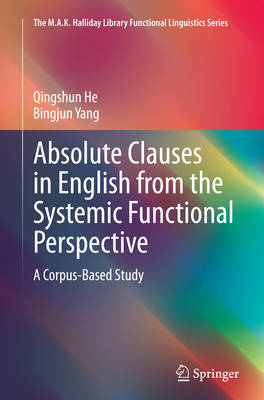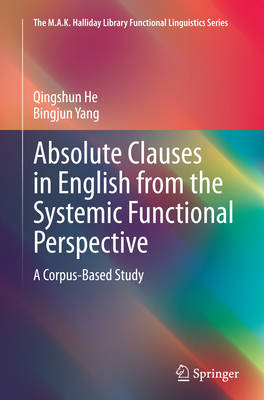
- Afhalen na 1 uur in een winkel met voorraad
- Gratis thuislevering in België vanaf € 30
- Ruim aanbod met 7 miljoen producten
- Afhalen na 1 uur in een winkel met voorraad
- Gratis thuislevering in België vanaf € 30
- Ruim aanbod met 7 miljoen producten
Zoeken
Absolute Clauses in English from the Systemic Functional Perspective
A Corpus-Based Study
Qingshun He, Bingjun Yang
€ 104,95
+ 209 punten
Uitvoering
Omschrijving
This book focuses on the structural diversity, semantic variability, case choice, stylistic characteristics and diachronic distribution of English absolute clauses. The syntactic roles assumed by absolute clauses in the traditional sense can be categorized into clausal adjuncts, attendant circumstances and appositives. These three types of function correspond to the three hypotactic expansions in the relation system of clause complexes in Systemic Functional Linguistics, i.e., elaboration, extension and enhancement. This research, therefore, redefines absolute clauses in the framework of SFL and proposes four syntactic types of absolute clauses: absolute paratactic clauses (elaboration), absolute hypotactic clauses (extension and enhancement), absolute projected clauses (fact and act) and absolute embedded clauses (subject). Based on the Brown family corpora, BNC and COHA, this research finds that different function types of absolute clauses differ in terms of their stylistic and diachronic distributions, and both nominative and accusative cases are acceptable.
Specificaties
Betrokkenen
- Auteur(s):
- Uitgeverij:
Inhoud
- Aantal bladzijden:
- 178
- Taal:
- Engels
- Reeks:
Eigenschappen
- Productcode (EAN):
- 9783662516355
- Verschijningsdatum:
- 9/10/2016
- Uitvoering:
- Paperback
- Afmetingen:
- 155 mm x 236 mm
- Gewicht:
- 349 g

Alleen bij Standaard Boekhandel
+ 209 punten op je klantenkaart van Standaard Boekhandel
Beoordelingen
We publiceren alleen reviews die voldoen aan de voorwaarden voor reviews. Bekijk onze voorwaarden voor reviews.








